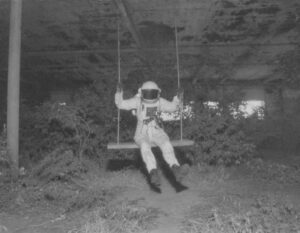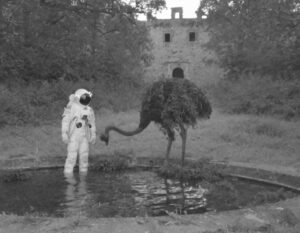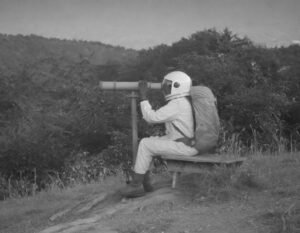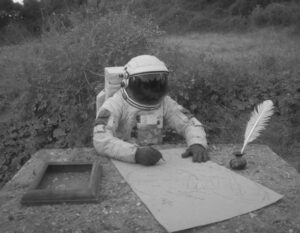Il Meccanico, a research space on contemporary artistic languages, in Verona, will host the two projects that won the call starting from April 5th: one created in analogic and the other built with Artificial Intelligence. The theme of the concept was “Rupture”, and the two works fit perfectly into it. Francesca Svampa exhibits “A Movie in a pic”, a collection of negatives that generate micro films. Giovanni Sellari instead proposes “Gli Stressonauti”, a project born from landscape shots on film but then “processed” by Artificial Intelligence. The protagonists are a group of intergalactic explorers who, tired of the frenzy and interstellar traffic, feel the need to take a long break to break their daily routine and detoxify from stress. To talk about this project we met Giovanni Sellari, contemporary art scholar, photographer, writer and creative.

Giovanni Sellari, “31. An astronaut in a white space suit has fun going on a swing inside an abandoned factory”, 2023, AI on images made on film, courtesy Il Meccanico, Verona
Simone Azzoni: Can you describe “Gli Stressonauti” project?
Giovanni Sellari: My project was born first and foremost from a personal need for a momentary escape from everyday life, from the intimate and mandatory need to find the space and time to dedicate to one of the most essential activities for maintaining psychophysical balance: idleness. I was born and raised in Papiano, a small town immersed in the greenery of Umbria, a place where life flows at a decidedly more sustainable speed compared to the rhythms of a fast and competitive city like Milan, where I have been living and working since 2011. For surviving all these years in such a hostile environment, I realized that, little by little, I began to adopt the survival strategies typical of astronauts: wearing a watertight space suit to protect myself from radiation and the lack of oxygen in the external environment (here they are called “brief meeting” and “pm10”) and spend as much time as possible inside my little spaceship (here they are called “studio apartments”). The idea and title of my project was born from this reflection: the protagonists are a group of intergalactic explorers who, tired of the frenzy and interstellar traffic, feel the need to take a long break to detoxify from the stress. They therefore decide to head towards a quiet provincial planet that has been uninhabited for some time now. Once they arrive on the planet, to find peace and contact with nature, few but strict rules are imposed: for the two months of their stay they will try to spend as much time as possible in solitude carrying out the simple activities that the wild planet can offer, they will not have to use technological tools in any way, and will not be able to connect or communicate with their working galaxy. As soon as they arrive on the planet, however, they find a film camera and two old black and white rolls of film still intact. Without too much effort, they decide to take one photo a day for sixty days. My project is nothing other than the fake photographic testimony of this idyllic leisure, melancholy and fun at the same time. A self-ironic rediscovery of the beauty that lies in the simplicity of moments empty of commitments, but full of reflection and self-rediscovery.

Giovanni Sellari, “27. An astronaut in a white spacesuit watches motionlessly as an ostrich drinks water from the fountain of an old castle”, 2023, AI on images made on film, courtesy Il Meccanico, Verona
On social media your project has a communicative identity…
Social media is a virtual space overflowing with happy photos of happy people having happy experiences in happy places, activating a system of “staging” the idyllic moment that transcends and mystifies the experience itself. On social media, with this project, I was gripped by competitive mania and, by publishing a photo a day for sixty days, I wanted to underline how much this “staging” is such. The transition from the virtual space of social media to a version materialized on paper, exhibited in a physical space, I believe leaves the ironic-mystifying intent of the project intact, but by changing the medium the perception of the message will certainly change too. Let me explain: these images are generated entirely by AI, but arise from landscape photographs taken on film, and taken specifically to be used as “reference images”. The visual result is a mimesis where analogue and AI confuse and hide each other. To emphasize this short circuit, within the exhibition space, I would like the images to return to the analogic role as much as possible: black and white printing on baryta paper which simulates the paper used in the darkroom, and an old projector with similar slides printed on transparency (tbd). A reference to modes of vision and exposure typically linked to the classic photography we trust, that “authentic” photography that we unconsciously still believe cannot lie.

Giovanni Sellari, “10. An astronaut in a white spacesuit, sitting on a wooden bench on top of a hill, looks at the horizon through a telescope”, 2023, AI on images made on film, courtesy Il Meccanico, Verona
Copy and originality; genius and creativity seem to be categories of thought already superseded by the contemporary paradigm. Why are we afraid of AI and what creative use can we make of it?
In 1859, in an essay entitled The modern public and author’s photography, Charles Baudelaire said that «photography was the refuge of all the failed painters, poorly gifted or too lazy to complete their studies, this universal frenzy had not only the character of blindness and imbecility, but also the color of revenge», thus not welcoming with open arms the invention of the daguerreotype which had occurred only a couple of decades earlier. I believe that in every historical period, art criticism and the artistic environment in general have always initially proven reluctant to technological innovations, which from time to time have broadened the catchment area in the production of images. Having said this premise, I believe that the fear towards AI is completely unjustified from the point of view of artistic production (another matter from the social point of view), indeed I personally welcomed it as a very useful creative tool for the purposes of experimentation which, in some cases, such as “Gli Stressonauti” cycle, it can even lead to actual production. In my artistic practice, in particular, always starting from an idea in written form which only subsequently transforms into an image, I must say that it was a very liberating transition. Then the use I’m making of it for now, after many attempts on almost all “text-to-image” platforms, is quite controlled and guided, where I’m still the one trying to impose the aesthetics of the project I have in mind, while always remaining well aware of the fact that the photographic image is by its nature autonomous and elusive to the impositions of the photographer, but this applies whether it is created analogic, digital or with AI. In Vaccari’s words, «it is not important that the photographer knows how to see, because the camera sees for him».

Giovanni Sellari, “11. An astronaut in a white spacesuit draws geometric shapes on a large sheet, near him an empty frame and an inkwell with a white feather”, 2023, AI on images made on film, courtesy Il Meccanico, Verona
How do you combine project, idea, object, image in your daily work?
Since 2021, together with three other friends and colleagues, I have founded Punctum Studio, based in Milan: a creative studio with a specific focus on storytelling. I am therefore lucky enough to do a very stimulating job from a creative point of view every day, together with a team of communication professionals who, like me, also pursue their personal path of artistic production. This is to say that the daily environment is fundamental for developing and training an aptitude for creation: the “forced” exercise towards the continuous production of new ideas, and the continuous exchange with trained and sincere people with whom to share experiments and drafts. The method is also very similar, since narration is always at the center of everything: both in everyday work and in artistic practice I always start from a blank paper sheet in which a story in written form slowly takes shape. This story, once outlined, is left to “decant” for a variable amount of time, in the meantime I compulsively search for as many visual stimuli as possible: inspirations necessary to start visualizing my idea in image form. I believe that it is precisely in this time of “decantation” that the real project takes shape, that is, when it is still halfway between the written word and visual intuition, because it is in this space that normally something “snaps” that puts everything in balance, or the story ends up in the giant scrap folder. If this click happens, all I have to do is finding everything I need to create the photograph that comes closest to the image I have in mind. This is why I don’t call myself a photographer, because I don’t think like a photographer. For me, photography is a visual trick: by its nature it is such a mimetic representation of reality that it allows my ideas to also seem real, and this creates confusion, a sort of blurred boundary, which I must say amuses me a lot.
Info:
Francesca Svampa, Giovanni Sellari, Analogue – Artificial
05/04/2024 – 30/04/2024
Il Meccanico
Via San Vitale 2b Verona
www.ilmeccanico.org

He is an art critic and professor of Contemporary Art History at IUSVE. He also teaches Critical Image Reading at the Palladio Institute of Design in Verona and Contemporary Art at the Master of Publishing at the University of Verona. He has curated several contemporary art exhibitions in unconventional places. He is the artistic director of the Grenze Photography Festival. He is a theater critic for national magazines and newspapers. He organizes research and experimentation theatrical events. Among the recent publications Frame – Videoarte e dintorni for the University Library, Lo Sguardo della Gallina for Lazy Dog Editions and for Mimemsis Smagliature in 2018 and 2021 for the same publishing house, Theater and photography.






NO COMMENT